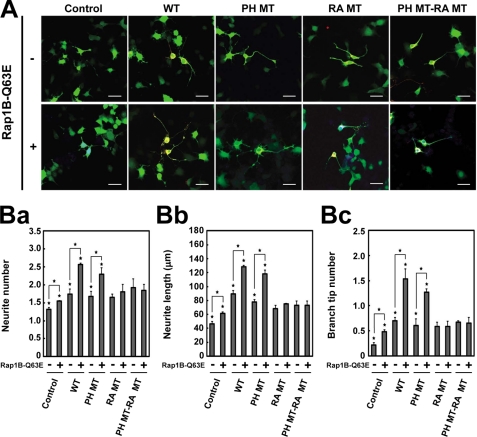FIGURE 7.
No involvement of PA binding to the PH domain in the Rap1B-Q63E-mediated neurite outgrowth. A, effects of RA-RhoGAP and its mutants on the Rap1B-Q63E-mediated neurite outgrowth in NG108 cells. NG108 cells were transfected with GFP (Control) or co-transfected with GFP as a morphological marker along with HA-RA-RhoGAP (WT), HA-RA-RhoGAP-PH MT (PH MT), HA-RA-RhoGAP-RA MT (RA MT), HA-RA-RhoGAP-PH MT-RA MT (PH MT-RA MT), myc-Rap1B-Q63E, both myc-Rap1B-Q63E and HA-RA-RhoGAP, both myc-Rap1B-Q63E and HA-RA-RhoGAP-PH MT, both myc-Rap1B-Q63E and HA-RA-RhoGAP-RA MT, or both myc-Rap1B-Q63E and HA-RA-RhoGAP-PH MT-RA MT, cultured in DMEM supplemented with 10% FBS for 48 h, and allowed to extend neurites. The transfected cells were identified by the expression of GFP (green), and the expressions of HA-RA-RhoGAP and myc-Rap1B-Q63E were examined by doubly staining with the anti-HA mAb (red) and the anti-Myc pAb (blue). Bars, 50 μm. B, quantitative analysis of the neurites outgrowth of the transfected NG108 cells. Panel a, quantitative analysis of the number of neurites per transfected cell as in Fig. 3C, panel a. Panel b, quantitative analysis of the length of neurites per transfected cell as in Fig. 3C, panel b. Panel c, quantitative analysis of the number of branch tips per transfected cell as in Fig. 3C, panel c. Asterisks indicate statistical significance (Student's t test; *, p < 0.01).

